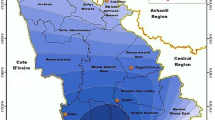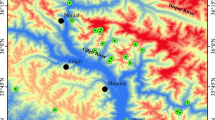Abstract
Although mercury (Hg) is ubiquitously present in natural ecosystems, human activities have promoted its accumulation and toxicity in the environment. The aim of this study was to assess the concentrations of total Hg (T-Hg) in different environmental matrices from two territories of Afro-descendant communities: Aires of Garrapatero (CCAG) and Cauca River Basin, Micro Basin of the Teta and Mazamorrero Rivers (CCMTM). Total Hg (T-Hg) was quantified using a direct Hg analyzer. The average T-Hg values from water and sediments collected in CCAG (0.86 ± 0.09 µg/L and 0.18 ± 0.02 µg/g) were statistically similar to those from CCMTM (0.65 ± 0.08 µg/L and 1.72 ± 0.64 µg/g). However, high Hg levels were detected in sediments from the Teta River (4.67 ± 1.32 µg/g). Surface soil displayed a pattern similar to that registered in sediments (0.09 ± 0.01 µg/g vs. 0.42 ± 0.14 µg/g). The contamination factor and geo-accumulation index of Hg in soil showed a relatively high degree of pollution with Hg at sites near the Teta River. In most fish species examined (53%), T-Hg concentrations were above the WHO limit (0.5 μg/g), with the highest levels (> 1.0 µg/g) found in Pseudopimelodus bufonius (2.53 µg/g), Saccodon dariensis (1.75 μg/g), and Gilbertolus sp. (1.04 µg/g). The most economically important fish species, Prochilodus magdalenae, registered 0.56 ± 0.06 µg/g. Risk assessment based on Hg exposure from diet suggested that the current Hg levels found in local fish represent considerable health risks for children, pregnant women, and adults. In short, the Teta River is a hotspot for Hg pollution in the territory and requires urgent remediation programs to reduce environmental exposure to this toxic metal. Moreover, fish consumption from species collected in local water bodies represents a health risk to the community. Both educational and monitoring programs are required to reduce adverse effects from Hg exposure.




Similar content being viewed by others
Data Availability
The authors declare that all data supporting the findings of this study are available within the article and from the corresponding author upon reasonable request.
References
Adewumi, A. J. (2020). Contamination, sources and risk assessments of metals in media from Anka artisanal gold mining area, Northwest Nigeria. Science of the Total Environment, 718, 137235. https://doi.org/10.1016/j.scitotenv.2020.137235
Alcala-Orozco, M., Caballero-Gallardo, K., & Olivero-Verbel, J. (2019). Mercury exposure assessment in indigenous communities from Tarapaca village, Cotuhe and Putumayo Rivers, Colombian Amazon. Environmental Science and Pollution Research International, 26, 36458–36467. https://doi.org/10.1007/s11356-019-06620-x
Alcala-Orozco, M., Caballero-Gallardo, K., & Olivero-Verbel, J. (2020). Biomonitoring of mercury, cadmium and selenium in fish and the population of Puerto Nariño, at the Southern Corner of the Colombian Amazon. Archives of Environmental Contamination and Toxicology, 79, 354–370. https://doi.org/10.1007/s00244-020-00761-8
Alcala-Orozco, M., Palomares-Bolaños, J., Alvarez-Ortega, N., Olivero-Verbel, J., & Caballero-Gallardo, K. J. (2021). Socio-economic and environmental implications of gold mining in Afro-descendant communities from Colombia. In Improving Quality of Life: Exploring Standard of Living, Wellbeing, and Community Development (pp. 127–150). IntechOpen.
Alvarez-Pugliese, C. E., Machuca-Martínez, F., & Pérez-Rincón, M. J. H. (2021). Water footprint in gold extraction: A case-study in Suárez, Cauca Colombia. Heliyon, 7(9), e07949. https://doi.org/10.1016/j.heliyon.2021.e07949
Barkdull, N. M., Carling, G. T., Rey, K., & Yudiantoro, D. F. (2019). Comparison of mercury contamination in four Indonesian Watersheds affected by artisanal and small-scale gold mining of varying scale. Water, Air, & Soil Pollution, 230(9), 1–18. https://doi.org/10.1007/s11270-019-4271-1
Bolaños-Álvarez, Y., Alonso-Hernández, C. M., Morabito, R., Díaz-Asencio, M., Pinto, V., & Gómez-Batista, M. (2016). Mercury contamination of riverine sediments in the vicinity of a mercury cell chlor-alkali plant in Sagua River Cuba. Chemosphere, 152, 376–382. https://doi.org/10.1016/j.chemosphere.2016.03.025
Buchman, M.F. (2008). Screening Quick Reference Tables (SQuiRTs). Available at https://repository.library.noaa.gov/view/noaa/9327
Carranza-Lopez, L., Caballero-Gallardo, K., Cervantes-Ceballos, L., Turizo-Tapia, A., & Olivero-Verbel, J. (2019). Multicompartment mercury contamination in major gold mining districts at the Department of Bolivar, Colombia. Archives of Environmental Contamination and Toxicology, 76, 640–649. https://doi.org/10.1007/s00244-019-00609-w
Corredor, J. A. G., González, G. L. V., Granados, M. V., Gutiérrez, L., & Pérez, E. H. (2021a). Use of the gray water footprint as an indicator of contamination caused by artisanal mining in Colombia. Resources Policy, 73, 102197. https://doi.org/10.1016/j.resourpol.2021.102197
Corredor, J. A. G., Pérez, E. H., Figueroa, R., & Casas, A. F. J. H. (2021b). Water quality of streams associated with artisanal gold mining; Suárez, Department of Cauca, Colombia. Heliyon, 7(6), e07047. https://doi.org/10.1016/j.heliyon.2021.e07047
Donkor, A. K., Bonzongo, J. C., Nartey, V. K., & Adotey, D. K. (2006). Mercury in different environmental compartments of the Pra River Basin Ghana. Science of the Total Environment, 368, 164–176.
Ekawanti, A., Priyambodo, S., Kadriyan, H., Syamsun, A., Lestarini, I., Wirasaka, G., & Ardianti, A. (2021). Mercury pollution in water and its effect on renal function of school age children in gold mining area Sekotong West Lombok. In IOP Conference Series: Earth and Environmental Science. IOP Publishing. 637, 012055. https://doi.org/10.1088/1755-1315/637/1/012055
Eltaib, L., Ali, S. E. T. E., & Rikabi, H. (2019). The exposure and toxic effects of mercury in gold mining activities. Asian Journal of Health Sciences, 5, 6–6. https://doi.org/10.1016/j.toxlet.2011.09.006
España, M. P., & Vidarte. L. M. (2012). Relaciones tróficas en el sistema hídrico de la provincia de los ríos: Ichthyoelephas humeralis y Brycon alburnus. Revista Científica Ciencias Naturales y Ambientales, 6, 3–18. https://doi.org/10.53591/cna.v6i1.198
Ferreira, S. L., Lemos, V. A., Silva, L. O., Queiroz, A. F., Souza, A. S., da Silva, E. G., dos Santos, W. N., & das Virgens, C. F. (2015). Analytical strategies of sample preparation for the determination of mercury in food matrices—a review. Microchemical Journal, 121, 227–236. https://doi.org/10.1016/j.microc.2015.02.012
Fischer, P., & Gustin, M. S. (2002). Influence of natural sources on mercury in water, sediment and aquatic biota in seven tributary streams of the East Fork of the Upper Carson River, California. Water, Air, and Soil Pollution, 133(1), 283–295. https://doi.org/10.1023/A:1012980511790
Gutiérrez-Mosquera, H., Marrugo-Negrete, J., Díez, S., Morales-Mira, G., Montoya-Jaramillo, L. J., & Jonathan, M. (2021). Mercury distribution in different environmental matrices in aquatic systems of abandoned gold mines, Western Colombia: Focus on human health. Journal of Hazardous Materials, 404, 124080. https://doi.org/10.1016/j.jhazmat.2020.124080
Hakanson, L. (1980). ç. An ecological risk index for aquatic pollution control A Sedimentological Approach. Water Research, 14, 975–1001. https://doi.org/10.1016/0043-1354(80)90143-8
Hernández-Morales, I., Paternina-Uribe, R., & Marrugo-Negrete, J. (2020). Contenido de metales pesados en sedimentos y peces provenientes de las ciénagas Marimonda y El Salado en Antioquia, Colombia. Gestión y Ambiente. 23(2), 239–249. https://doi.org/10.15446/ga.v23n2.81611
Howard, J., Trotz, M. A., Thomas, K., Omisca, E., Chiu, H. T., Halfhide, T., Akiwumi, F., Michael, R., & Stuart, A. L. (2011). Total mercury loadings in sediment from gold mining and conservation areas in Guyana. Environmental Monitoring and Assessment, 179(1), 555–573. https://doi.org/10.1007/s10661-010-1762-3
Lide, D. (2008). CRC handbook of chemistry and physics, geophysics, astronomy, and acoustics. Section 14, abundance of elements in the Earth’s Crust and in the Sea, 89th edn. CRC Press.
Marrugo-Negrete, J., Benitez, L. N., & Olivero-Verbel, J. (2008). Distribution of mercury in several environmental compartments in an aquatic ecosystem impacted by gold mining in northern Colombia. Archives of Environmental Contamination and Toxicology, 55, 305–316. https://doi.org/10.1007/s00244-007-9129-7
Marrugo-Negrete, J., Pinedo-Hernández, J., Paternina-Uribe, R., Quiroz-Aguas, L., & Pacheco-Florez, S. (2018). Spatial distribution and evaluation of environmental pollution by mercury in the Mojana region, Colombia. Revista MVZ Córdoba, 23, 7062–7075. https://doi.org/10.21897/rmvz.1481
MME. (2019). MME. Ministry of Mines and Energy. Iniciativas para la transparencia de las industrias extractivas. https://www.eiticolombia.gov.co/es/datos-del-sector/#home8 (Accessed 6 Jan 2022).
Mosquera, F. M. M., & Asprilla, Y. D. M. (2017). Contaminación mercurial en peces y sedimentos del río Timbiquí, Consejo Comunitario Mayor Renacer Negro, departamento del Cauca. Revista Bioetnia. 14(1), 55–64. https://doi.org/10.51641/bioetnia.v14i1.179
Olivero, J., Solano, B., & Acosta, I. (1998). Total mercury in muscle of fish from two marshes in goldfields, Colombia. Bulletin of Environmental Contamination Toxicology, 61, 182–187. https://doi.org/10.1007/s001289900746
Olivero-Verbel, J., Young-Castro, F., & Caballero-Gallardo, K. (2014). Contaminación por mercurio en aire del distrito minero de San Martín de Loba en el departamento de Bolívar, Colombia. Revista Internacional De Contaminación Ambiental, 30, 07–13.
Olivero-Verbel, J., Caballero-Gallardo, K., & Turizo-Tapia, A. (2015). Mercury in the gold mining district of San Martin de Loba, South of Bolivar (Colombia). Environmental Science Pollution Research, 22, 5895–5907. https://doi.org/10.1007/s11356-014-3724-8
Olivero-Verbel, J., Carranza-Lopez, L., Caballero-Gallardo, K., Ripoll-Arboleda, A., & Muñoz-Sosa, D. (2016). Human exposure and risk assessment associated with mercury pollution in the Caqueta River, Colombian Amazon. Environmental Science Pollution Research, 23, 20761–20771. https://doi.org/10.1007/s11356-016-7255-3
Osorio-García, A. M., Paz, L., Howland, F., Ortega, L. A., Acosta-Alba, I., Arenas, L., Chirinda, N., Martínez-Barón, D., Bonilla Findji, O., & Loboguerrero, A. M. (2020). Can an innovation platform support a local process of climate-smart agriculture implementation? A case study in Cauca, Colombia. Agroecology and Sustainable Food Systems, 44, 378–411. https://doi.org/10.1080/21683565.2019.1629373
Palacios-Torres, Y., Caballero-Gallardo, K., & Olivero-Verbel, J. (2018). Mercury pollution by gold mining in a global biodiversity hotspot, the Choco biogeographic region, Colombia. Chemosphere, 193, 421–430. https://doi.org/10.1016/j.chemosphere.2017.10.160
Pinedo-Hernández, J., Marrugo-Negrete, J., & Díez, S. (2015). Speciation and bioavailability of mercury in sediments impacted by gold mining in Colombia. Chemosphere, 119, 1289–1295. https://doi.org/10.1016/j.chemosphere.2014.09.044
Rocha-Román, L., Olivero-Verbel, J., & Caballero-Gallardo, K. (2018). Impacto de la minería del oro asociado con la contaminación por mercurio en suelo superficial de San Martín de Loba, sur de Bolívar (Colombia). Revista Internacional de Contaminación Ambiental, 34, 93–102. https://doi.org/10.20937/RICA.2018.34.01.08
Rúa, A., Liebezeit, G., & Palacio-Baena, J. (2014). Mercury colonial footprint in Darién Gulf sediments, Colombia. Environmental Earth Sciences, 71, 1781–1789. https://doi.org/10.1007/s12665-013-2583-9
SIMCO. (2022). SIMCO. Sistema de Información Minero Colombiano. https://www1.upme.gov.co/simco/Cifras-Sectoriales/Paginas/oro.aspx (Accessed 6 Jan 2022).
Ulloa, A. J. D. (2017). Dinámicas ambientales y extractivas en el siglo XXI:¿ es la época del Antropoceno o del Capitaloceno en Latinoamérica? Desacatos, 54, 58–73.
USEPA. (1989). USEPA risk assessment guidance for superfund vol 1: Human health evaluation manual (Part A interim final, EPA/540/1–89/002). USEPA. https://www.epa.gov/sites/default/files/2015-09/documents/rags_a.pdf
USEPA. (1999). Mercury update: impact on fish advisories. EPA-823-F-99–016. Available at https://www.epa.gov/sites/default/files/2019-05/documents/mercury-update-fish-advisories-1999.pdf
USEPA. (2000). Guidance for assessing chemical contamination data for use in fish advisories, vol II. Risk assessment and fish consumption limits EPA/823-B94–004. Washington, DC. https://www.epa.gov/sites/default/files/2015-06/documents/volume2.pdf
USEPA. (2018a) edition of the drinking water standards and health advisories Tables, EPA 822-F-18–001. Washington, D.C.: United States Environmental Protection Agency. https://www.epa.gov/sites/default/files/2018a-03/documents/dwtable2018.pdf
USEPA-FDA. (2018). United States Environmental Protection Agency. Food and Drug Administration. EPA-FDA Fish Advice: Technical Information. Available at https://19january2021snapshot.epa.gov/fish-tech/epa-fda-fish-advice-technical-information_.html
Veiga, M. M., Maxson, P. A., & Hylander, L. D. (2006). Origin and consumption of mercury in small-scale gold mining. Journal of Cleaner Production, 14(3-4), 436–447.https://doi.org/10.1016/j.jclepro.2004.08.010
Vélez-Torres, I., Vanegas, D. C., McLamore, E. S., & Hurtado, D. (2018). Mercury pollution and artisanal gold mining in Alto Cauca, Colombia: Woman’s perception of health and environmental impacts. The Journal of Environment Development, 27, 415–444. https://doi.org/10.1177/1070496518794796
Vieira, H., Bordalo, M., Figueroa, A., Soares, A., Morgado, F., Abreu, S., & Rendón-von Osten, J. (2021). Mercury distribution and enrichment in coastal sediments from different geographical areas in the North Atlantic Ocean. Marine Pollution Bulletin, 165, 112153. https://doi.org/10.1016/j.marpolbul.2021.112153
WHO. (2008). Guidelines for Drinking-water Quality Third edition incorporating the first and second addenda. Volume 1. Recommendations. https://www.who.int/water_sanitation_health/dwq/fulltext.pdf (Accessed 11 Jan 2022).
WWF. (2021). WWF, World Wildlife Fund. Glosario ambiental: ¿Qué es la biodiversidad?. https://www.wwf.org.co/en/?328100/Glosario-ambiental-Que-es-la-biodiversidad (Accessed 6 Jan 2022).
Acknowledgements
The authors would like to thank Luis Ricardo-Navarro, Neda Alvarez-Ortega, Javier Galvis-Ballesteros, Maria Quintana-Mejía, and the Afro-descendant communities of Cauca for their participation in this project.
Funding
The Ministry of Science, Technology and Innovation (Minciencias), the Ministry of Health and Social Protection (Minsalud), and the University of Cartagena (Grant: 943/2019) funded this project.
Author information
Authors and Affiliations
Contributions
All the authors contributed to research for the development of this manuscript according to his/her expertise. All the authors read and approved the final manuscript.
Corresponding author
Ethics declarations
Conflict of Interest
The authors declare no competing interests.
Additional information
Publisher's Note
Springer Nature remains neutral with regard to jurisdictional claims in published maps and institutional affiliations.
Supplementary Information
Below is the link to the electronic supplementary material.
Rights and permissions
About this article
Cite this article
Caballero-Gallardo, K., Palomares-Bolaños, J. & Olivero-Verbel, J. Mercury Concentrations in Water, Sediments, Soil, and Fish Around Ancestral Afro-Descendant Territories Impacted by Gold Mining in the Cauca Department, Colombia. Water Air Soil Pollut 233, 393 (2022). https://doi.org/10.1007/s11270-022-05779-3
Received:
Accepted:
Published:
DOI: https://doi.org/10.1007/s11270-022-05779-3




